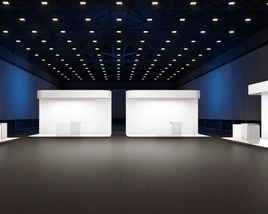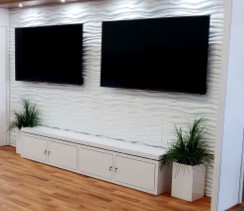Once you’ve chosen your trade show schedule and reserved your booth space, the real work begins. Whether it’s your first time shopping for trade show booths or you’re planning a display that’s bigger and better than anything you’ve done before, designing a booth to meet a deadline requires careful planning.
To get started, start thinking about how you will use your booth at each show. Custom portable trade show exhibits can incorporate a variety of features including second floors, conference rooms, theater presentations, plasma screens, demo stations, product shelving, and storage – and each type of booth requires its own unique timeline. But how do you know when to start the process?
To help you stay organized and efficient at your next event, we’ve created a timeline that takes the guesswork out of designing custom portable trade show exhibits. With this helpful guide, you’ll know exactly when each step of your production process needs to be completed, helping you ensure that your trade show booth comes together without hitch—and rush fees. And also avoid mistakes.
Work backward from the date of your show when you follow this timeline—and whatever you do, don’t wait until the last minute to plan your performance.
Three months before the show if you’re planning an island display, now is the time to start the design process, which usually takes four weeks to perfect. You don’t need much time to design a 10×20 and smaller trade show booth. Two weeks is usually sufficient to include an initial consultation, the first design, and any modifications. If you plan to use a standard kit, little design time is required and you can skip this step.
Two months before the show the design should be complete and your trade show should be in production. However, production times vary for different types and sizes of trade shows. Island trade show booths generally require 30 business days, while 10×20 and smaller trade show booths generally require 15 business days. Pop-up trade show displays can take up to 10 business days.
While your booth is in production, now is a great time to begin the creative design of your trade show display graphics. Allow two to three weeks for graphic design, whether you use your own designer or a freelancer. You’ll want plenty of time to revise and approve all of the graphic designs before sending the final file to print.
Keep in mind that you’ll be working with very large files that often can’t be e-mailed. Sometimes these files can be uploaded to an FTP site, but some are too large for this and require mailing to disk. Once the trade show display company has received your graphic files, it will perform a proof to test the color and quality before printing the final files. Proofing and final production of your trade show display graphics may take another five to 10 business days, depending on the size of the job.
Production of your trade show booth should be completed three weeks prior to the show. If possible, send your finished display to your exhibition house for a preview. Ground shipping can take up to five business days, making it the most cost-effective way to transport your exhibits. We recommend at least a week of preview time, which also allows the exhibit house to properly fit the graphics on your display. You can also take this time to familiarize yourself with your booth before you get on the trade show floor.
One Week Before the Show
Time to send your trade show booth to the show site. Again, make sure you plan for five business days for ground shipping—expedited shipping can increase your costs significantly. You’ll also want to check your exhibitor’s manual for any arrival time limits.
Experienced exhibitors will tell you, successful trade show booths don’t happen overnight. Instead, you’ll need careful planning and forethought to design the display smoothly. So follow this timeline and pay careful attention to your event’s requirements, including deadlines for ordering booth services. Because when you create a sensational trade show exhibit, all that planning will be worth every second.
How to Make Rental Trade Show Exhibits Pay Off
There are times when renting, versus owning, a trade show exhibit makes good sense. It may be that your primary trade show booth is already in use at another show; you have budget or turnaround time constraints; Or maybe you’re testing out the trade show experience for the first time.
Whatever the case, here are five basic guidelines that will make your trade show exhibit rental experience hassle-free and successful:
Find Highly Transportable Solutions
Find a rental trade show display that can be set up easily and quickly to save on trade show display installation and dismantling costs. Choose trade show exhibits that are built to survive unexpected transportation and to ensure fast, flawless trade show exhibit assembly and fast, fool-proof trade show exhibit breakdown.
Choose Lightweight Structures
Today you can find exceptionally stable, yet lightweight platforms such as the High Tech Aluminum Extrusion Profile Form that can act as the backbone of your trade show display. Straight and curved modular elements in varying lengths work together in nearly limitless combinations to create a unique, personalized rental trade show exhibit booths.
Look for Versatility
Being flexible is the key to providing a solution for rental trade show exhibition environments – from trade show booth interiors and dividing walls to free-standing podium additions or other options.
You can define the location of your trade show exhibit area by starting with a freestanding platform. You may want to create an island of calm for serious prospects amidst the noise and chaos of the typical show floor. Today’s versatile rental trade show display systems also feature modular wall elements that can serve to enclose some or all of your exhibit space.
Go for Clean, Clear, Crisp, and Creative Functional Designs
By using advanced high-tech design solutions, you will be able to have a rental trade show booth that can broadcast your company’s message in a focused and powerful way. Contemporary rental trade show exhibit structures can be custom designed to create a personalized trade show floor statement that expresses your company’s marketing goals and objectives.
Create an Environment for Interaction Between your Sales Force and hot Prospects
Whether it’s a rental trade show exhibit or a permanent trade show exhibit, the ideal trade show display allows for person-to-person interaction through attention to traffic flow within the display and careful placement of exhibit design elements for maximum efficiency and accessibility of product displays. encourages conversation. product displays, and marketing literature. Make it easy for your attendees to feel at home with visual and accessible literature. Set up display areas designed to attract attendees and make the experience comfortable.
Try imaginative and innovative trade show exposure ideas when you hire. This is a great way to test out trade show exhibit options before purchasing permanent exhibits or making a major trade show booth commitment.
By following the rental trade show booth tips mentioned above, you will be on your way to a successful rental trade show display experience. This is true whether you have a custom trade show exhibit rental or a custom modular exhibit rental, whether the trade show exhibit is at the Las Vegas Convention Center, the Moscone Center in San Francisco, the Santa Clara Convention Center, or the San Jose McEnery Convention Center.
Mistakes to Avoid in Trade Show Display
Creating a successful trade show display requires many tasks: selecting the right exhibit company, selecting your target audience, selecting design features, simplifying the text, and more. However, avoiding certain activities can also contribute to more profitable custom performance. Avoiding these mistakes is an important part of creating the highest quality, most economical performance possible for your business. Here are some of the most common mistakes that exhibitors make that can affect success.
Failing to Read the Exhibitor’s Manual
You should receive an Exhibitor’s Manual for each trade show you register for. This manual is a comprehensive list of the rules and regulations governing your time at the trade fair. For example, this should include equipment rental deadlines, the types of lighting that are (or are not) allowed at the show, the kind of technology that can be supported, and so forth. If you read it carefully, you should know everything you need to perform successfully in that show.
Unfortunately, many exhibitors fail to read this manual due to boredom or the mistaken belief that they already know all the rules. The truth is, however, that each trade show has its own specific rules that may affect the design of your exhibit booth. For example, regulations regarding the height of your custom display, the type of lighting allowed, and delivery deadlines can all affect when and how you design your display. Reading the Exhibitor’s Manual before starting the design process with your exhibit company can prepare you to make decisions that will follow the rules of your trade show.
Choosing the Wrong-Sized Display
Another common error occurs before the design process even begins. This error involves choosing the wrong size display. For example, if you reserve one booth size and build another, you may end up with custom displays that don’t quite fit. Alternatively, your booth location and the display may match, but the size may not suit your needs.
For example, overly large displays can eat up so much of your budget that you have nothing left over to design your large display. Plus, if you go too big, you run the risk of having a display that looks empty because you simply can’t draw enough visitors to make the space worth it.
Alternatively, small displays can make your booth feel overcrowded. And an overcrowded booth may discourage visitors who would otherwise stop by. Or, it could make you insignificant if your competitors bring in bigger performances. Also, while you will likely save money with a smaller booth, you may find that a smaller booth does not meet the needs of your business if you grow rapidly over the course of a few years. The key is to choose a booth size that meets your needs, captures the attention of your visitors, and leaves you enough money to create a unique trade show display.
Failing to Plan Ahead
One of the most common mistakes exhibitors make is failing to plan ahead. Simply building a unique trade show display requires 6-8 weeks of manufacturing. It takes even more time to hone your vision and create and refine a design. A good rule of thumb is to give yourself and your exhibit company 4 to 6 months to complete the process of creating a custom trade show display. Anything less than that, and you might not get your display in time.
In addition, failure to plan ahead can mean missing deadlines at the trade show (such as for trade show equipment rental or delivery windows). Or, it may mean losing out on lower rates for reservations, materials, and services available to those who request them ahead of time.
Failing to plan ahead can also result in a less effective custom trade show exhibit. For example, if you don’t develop a marketing strategy and set goals for your exhibit, it will be difficult to create an exhibit that meets your trade show needs. Without setting goals, an understanding of your target audience, and a focused message, you’re unlikely to attract the leads you need to make your time at the trade show worthwhile. Planning your marketing strategy and your display needs ahead of time can result in a less expensive but more effective custom trade show exhibit.
Focusing on Cost Rather than Quality
Creating a unique trade show display on a budget can be a challenge, especially if your budget is small. This is why many exhibitors try to build their displays with the least expensive materials and the most affordable design services possible. They hope to get a successful trade show display without spending much.
Unfortunately, this strategy rarely works. By using cheap materials and cheap design services, you run the risk of getting what you pay for: shoddy designs that wear out quickly or don’t function as they should.
Instead of making cost the most important element in your design decisions, consider making quality the most important. This may mean that you have to build a smaller display or add fewer features. However, choosing quality materials and an experienced exhibition company doesn’t mean you should give up on your budget. Instead, your display company’s design services should be able to work with you to innovate less expensive solutions that don’t compromise on quality.
Trade show display mistakes may be common, but they are not inevitable. If you can avoid them, you can save yourself time, money, and stress both during the design process and during the trade show. If you read the exhibitor’s manual, choose the right size display, plan ahead, and focus on quality rather than cost, you should end up with a beautiful, unique trade show display. By avoiding the hassles of many other exhibitors, you can enjoy a more profitable and less stressful time at your trade show.




